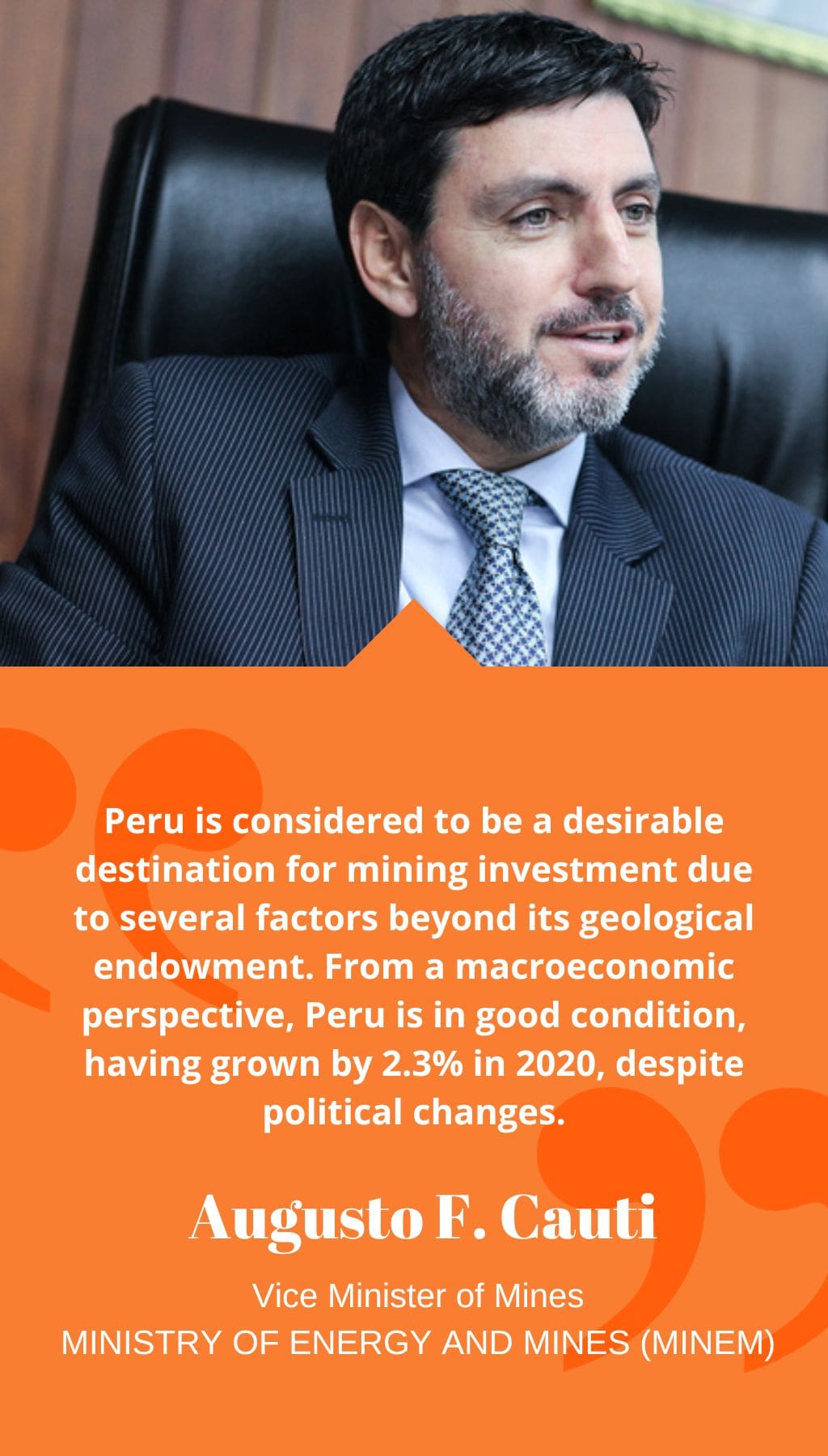
- Peru | 19 June 2021

Can you explain the vision of the Ministry of Energy and Mines (MINEM) for 2021?
The aim of MINEM is to promote the sustainable development of mining in Peru, with a focus not just on economic growth, but also on environmental and social aspects. Peru’s mining sector received over US$6.15 billion in investment in 2019, and this is expected to increase to around US$6.3 billion in 2020. This would mark the fourth consecutive year of growth, contributing to over 10% of the country’s GDP and around 60% of its exports. Increasing investment in exploration is a key objective for 2021.
Peru is the number one producer of gold, zinc, lead, and tin in Latin America, and the second largest producer of copper and silver worldwide. Production figures for copper, lead, tin, molybdenum, and iron increased in 2019, and by 2022, copper production is expected to increase by 27%, with gold production rising by approximately 12%.
What steps can be taken to stimulate exploration?
While the amount of exploration investment in 2019 was not as high as expected, Peru still had the fifth largest exploration budget in the world at US$609.7 million, behind only Canada, Australia, the USA, and Mexico. Peru’s geological potential and mining tradition continue to make it a highly attractive destination for exploration.
To stimulate exploration, the government granted a decree of urgency on December 27th, 2019, which provides the definitive devolution of VAT for the next three years. Additionally, legislation was reinstated that allows companies that invest large amounts in the country to perform accounting in US dollars. The government is also reviewing adjustments to specific legislation to expedite permitting processes while maintaining the highest environmental and safety standards.
How is the government promoting sustainable mining practices?
The government is committed to promoting sustainable mining practices in Peru. To this end, MINEM has established various initiatives, including promoting the use of renewable energy, such as wind and solar power, in mining operations. Additionally, the government is implementing measures to reduce water consumption and increase the reuse of wastewater.
Furthermore, the government has increased efforts to regulate and monitor the environmental impact of mining activities. This includes strict compliance with environmental regulations and the requirement for mining companies to develop environmental impact assessments for their operations. The government also works to promote social responsibility and community engagement in mining projects to ensure that they benefit local communities.
What are the challenges facing the mining sector in Peru?
One of the challenges facing the mining sector in Peru is the need to balance economic growth with environmental and social considerations. The government is working to promote sustainable mining practices and ensure that mining activities are conducted in an environmentally responsible manner.
Another challenge is the need for more investment in exploration to identify new mineral deposits. The government is implementing various measures to stimulate exploration and increase investment in this area.
Additionally, there is a need to address social issues related to mining, such as the impact of mining activities on local communities and the need to ensure that communities benefit from mining projects. The government is working to promote social responsibility and community engagement in mining projects to ensure that local communities benefit from the sector.
Can you explain why Peru is an attractive destination for mining investment beyond its geological resources?
Yes, Peru is considered to be a desirable destination for mining investment due to several factors beyond its geological endowment. From a macroeconomic perspective, Peru is in good condition, having grown by 2.3% in 2020, despite political changes. In fact, Peru has the best Emerging Markets Bond Index (EMBI) country risk rating of all the other mining-focused countries in Latin America, according to data released by JP Morgan in January 2020.
Additionally, Peru boasts a rich mining tradition, which has fostered a skilled mining labor force. The country has competitive prices for energy and electricity, which helps to keep production costs down. Moreover, Peru’s open economy and welcoming constitution create an environment that is conducive to both local and international investment that can contribute to the development of Peru’s diverse resources and, most importantly, its people.
Could you provide more information about the investment being made in Peru’s mining sector?
In 2019, Peru’s mining sector received over US$6.15 billion in investment, and we expect this figure to increase to around US$6.3 billion in 2020, marking the fourth consecutive year of growth. This sustained growth is significant, as mining contributes over 10% to Peru’s GDP and accounts for approximately 60% of the country’s exports.
Peru’s mining production figures have also been impressive, with increased production of copper, lead, tin, molybdenum, and iron in 2019. Furthermore, Peru is the number one producer of gold, zinc, lead, and tin in Latin America, and the second largest producer worldwide of copper and silver. We expect copper production to increase by 27% and gold production to rise by 12% by 2022.
How is the Peruvian government encouraging exploration in the country?
Although exploration investment in Peru did not reach the expected level in 2019, Peru still had the fifth largest exploration budget in the world at US$609.7 million, behind only Canada, Australia, the USA, and Mexico. We believe that Peru’s geological potential and mining tradition make it a highly attractive destination for exploration.
To stimulate exploration, the Peruvian government granted a decree of urgency on December 27, 2019, to provide a definitive devolution of VAT for the next three years. We have also reinstated legislation that allows companies that invest large amounts in the country to perform accounting in US dollars. Additionally, we are reviewing adjustments to specific legislation to expedite permitting processes while upholding the highest environmental and safety standards.














